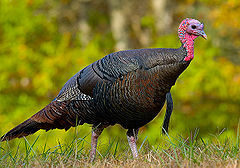(Meleagris gallopavo )

Wild turkeys are the largest game birds in Georgia and are members of the pheasant family. The male called a gobbler or Tom, has dark iridescent feathers feathers with areas of red, purple, green, copper, bronze, and gold; red wattles on the throat; and a dark tuft suspended from the breast also known as a beard. The female, called a hen, is duller than the male, lacks wattles, and often lacks a breast tuft. Males measure 46 in from beak tip to tail tip; females measure 37 in. A long neck, featherless blue head, strong spurred legs, and a fan-shaped tail. Image at right is of a female Wild Turkey. Click on the image for more detailed information.
The Wild Turkey is a non-territorial, polgynous bird. However, occasionally, wild turkeys may behave aggressively towards humans, especially in areas where natural habitats are scarce. Preferred habitats include mature forests, open woodlands, and farm areas. They spend their days foraging for food like acorns, seeds, small insects and wild berries. They roost at nights in low branches of trees.
Males perform courtship displays by strutting and gobbling. Females mate with them and then nest by themselves. Nests are shallow depressions scratched into the ground. Common habitat for nesting is open woodland. Nests are often concealed under brush, grass, or shrubs. Egg-laying begins in late March; 10 to 12 eggs are laid. Eggs are white with light brown spots. Incubation lasts 28 days. Within one day of hatching, the young birds, called poults, are able to walk. By day two, the hen and poults form an organized feeding line. Hen and young remain together and may join other brood flocks through the summer and fall. Male young leave the brood hen in late fall to join other males. Female young leave the following spring. At this time the female flocks break up, forming smaller groups of females attended by 1 – 4 adult males.
Adults and poults succumb to predation by Raccoon, foxes, and Bobcats. Nests may be attacked by
Raccoons, Opossums, skunks, foxes, snakes, and rodents.
At the turn of the 20th century, Wild Turkey populations declined tremendously because of hunting and habitat loss. Populations have since increased due to game management and and regrowth of forests that were cut down in the 1900’s. There has been a recent reduction in wild turkey population, and it is being researched by team at UGA’s Warnell School of Forestry and Natural Resources. One of the factors that seems to be causing the decline is the growth in populations of predators mentioned above. Also, they have found decapitated turkeys and believe this may be attributed to Great Horned Owls looking for food.
The Wild Turkey occurs year-round in northwestern Georgia and in the southern third of the State.
Fun Facts
Benjamin Franklin never proposed the turkey as a symbol for America, but he did once praise it as being “a much
more respectable bird” than the bald eagle.
The male gobble can be heard for up to a mile away.
A turkey’s gender can be determined from its droppings–males produce spiral-shaped poop and females’ poop is shaped like the letter J.
Wild turkeys have very powerful legs and can run at speeds up to 25 miles per hour. Their top speed in flight is 55 miles per hour.

